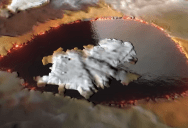NASA Releases Incredible Video Of Reflective Lava Lake On Jupiter’s Hellish Moon
by Michael Levanduski

There is really something special about sitting beside a lake on a calm day, enjoying the mirror-like reflection off of the water.
While that scene may be unforgettable, NASA has recently released a video that shows something similar from Jupiter’s moon IO… except instead of water, it’s lava!
The Jet Propulsion Laboratory (JPL) at NASA has taken data gathered from the Juno spacecraft, which performed flybys last February and December and used it to create a stunning rendition of what the lakes would look like in person.
IO orbits approximately 217,000 miles above Jupiter, which is only a little bit further than our Moon orbits Earth. One of the images generated by JPL illustrates what Jupiter would look like from the shores of one of these lava lakes.

Scott Bolton, the principal investigator working on Juno for NASA, talked about the volcanos and the lake that was observed.
“IO is simply littered with volcanoes, and we caught a few of them in action. We also got some great close-ups and other data on a 200-kilometer-long (127-mile-long) lava lake called Loki Patera.”
In addition to being captivated by the incredible beauty of the images, scientists are fascinated about this environment, which has some similarities to how obsidian glass was formed on Earth.
“There is amazing detail showing these crazy islands embedded in the middle of a potentially magma lake rimmed with hot lava. The specular reflection our instruments recorded of the lake suggests parts of Io’s surface are as smooth as glass, reminiscent of volcanically created obsidian glass on Earth.”

While it may sound tropical, you would not want to live there (or even visit).
IO has an average surface temperature of around -202 degrees Fahrenheit. The volcanoes on the moon, which feed this lake, can reach as high as 3000 degrees.
No Thanks!
While we may not want to visit, we loved watching the video released by NASA’s JPL.
Check it out:
Pretty impressive!
If you thought that was interesting, you might like to read a story that reveals Earth’s priciest precious metal isn’t gold or platinum and costs over $10,000 an ounce!

Sign up to get our BEST stories of the week straight to your inbox.




